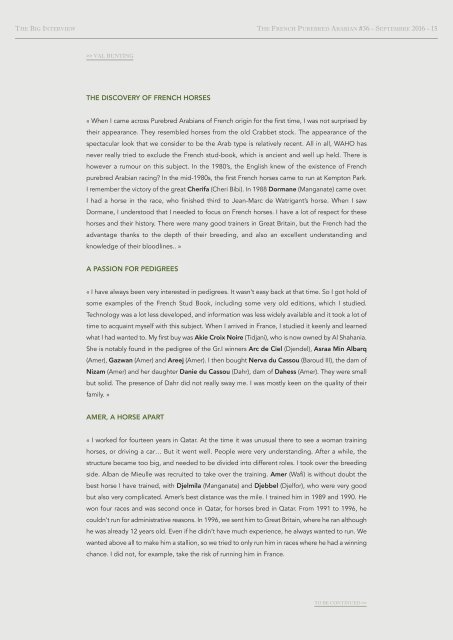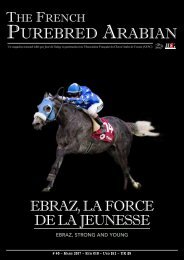Create successful ePaper yourself
Turn your PDF publications into a flip-book with our unique Google optimized e-Paper software.
The biG inTerVieW The French <strong>Purebred</strong> <strong>ArAbiAn</strong> #36 - SePTembre 2016 - 15<br />
>> VAL bunTinG<br />
the discOVery Of french hOrses<br />
« When I came across <strong>Purebred</strong> Arabians of French origin for the first time, I was not surprised by<br />
their appearance. They resembled horses from the old Crabbet stock. The appearance of the<br />
spectacular look that we consider to be the Arab type is relatively recent. All in all, WAHO has<br />
never really tried to exclude the French stud-book, which is ancient and well up held. There is<br />
however a rumour on this subject. In the 1980’s, the English knew of the existence of French<br />
purebred Arabian racing? In the mid-1980s, the first French horses came to run at Kempton Park.<br />
I remember the victory of the great cherifa (Cheri Bibi). In 1988 dormane (Manganate) came over.<br />
I had a horse in the race, who finished third to Jean-Marc de Watrigant’s horse. When I saw<br />
Dormane, I understood that I needed to focus on French horses. I have a lot of respect for these<br />
horses and their history. There were many good trainers in Great Britain, but the French had the<br />
advantage thanks to the depth of their breeding, and also an excellent understanding and<br />
knowledge of their bloodlines.. »<br />
a passiOn fOr pedigrees<br />
« I have always been very interested in pedigrees. It wasn’t easy back at that time. So I got hold of<br />
some examples of the French Stud Book, including some very old editions, which I studied.<br />
Technology was a lot less developed, and information was less widely available and it took a lot of<br />
time to acquaint myself with this subject. When I arrived in France, I studied it keenly and learned<br />
what I had wanted to. My first buy was akie croix noire (Tidjani), who is now owned by Al Shahania.<br />
She is notably found in the pedigree of the Gr.I winners arc de ciel (Djendel), asraa min albarq<br />
(Amer), gazwan (Amer) and areej (Amer). I then bought nerva du cassou (Baroud III), the dam of<br />
nizam (Amer) and her daughter danie du cassou (Dahr), dam of dahess (Amer). They were small<br />
but solid. The presence of Dahr did not really sway me. I was mostly keen on the quality of their<br />
family. »<br />
amer, a hOrse apart<br />
« I worked for fourteen years in Qatar. At the time it was unusual there to see a woman training<br />
horses, or driving a car… But it went well. People were very understanding. After a while, the<br />
structure became too big, and needed to be divided into different roles. I took over the breeding<br />
side. Alban de Mieulle was recruited to take over the training. amer (Wafi) is without doubt the<br />
best horse I have trained, with djelmila (Manganate) and djebbel (Djelfor), who were very good<br />
but also very complicated. Amer’s best distance was the mile. I trained him in 1989 and 1990. He<br />
won four races and was second once in Qatar, for horses bred in Qatar. From 1991 to 1996, he<br />
couldn’t run for administrative reasons. In 1996, we sent him to Great Britain, where he ran although<br />
he was already 12 years old. Even if he didn’t have much experience, he always wanted to run. We<br />
wanted above all to make him a stallion, so we tried to only run him in races where he had a winning<br />
chance. I did not, for example, take the risk of running him in France.<br />
TO be cOnTinued >>




